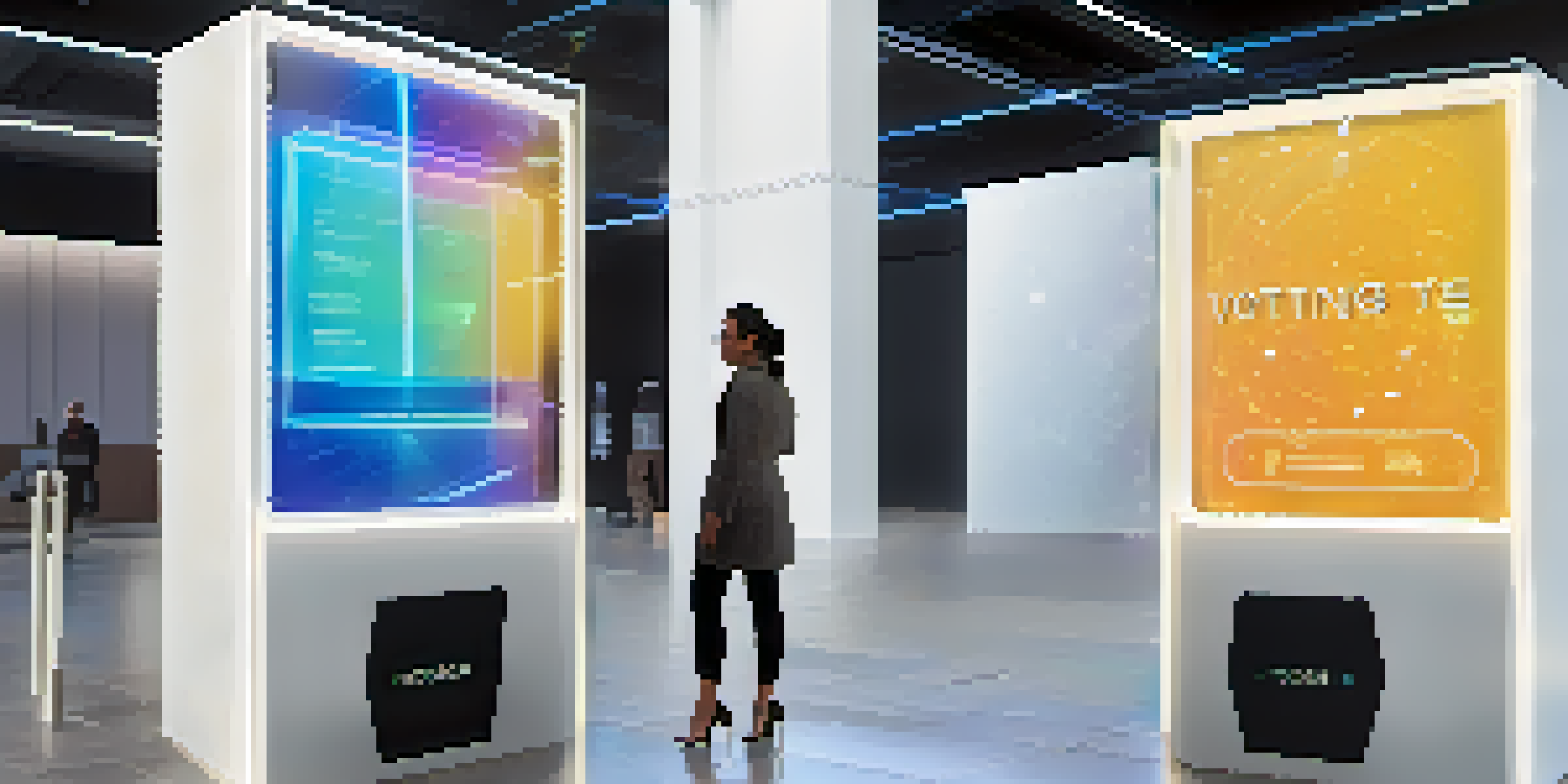Blockchain-Based Voting Systems: Ensuring Election Integrity

Understanding Blockchain Technology in Voting
Blockchain technology is often associated with cryptocurrencies, but its potential extends far beyond digital coins. At its core, a blockchain is a decentralized ledger that records transactions across many computers, ensuring that the information is secure and cannot be altered retroactively. This technology can revolutionize voting by providing a transparent and tamper-proof method of recording votes.
Blockchain is the tech. Bitcoin is merely the first mainstream manifestation of its potential.
Imagine a traditional voting system, where ballots can be lost or tampered with, leading to questions of trust and legitimacy. In contrast, blockchain creates a digital trail for each vote cast, making it nearly impossible for anyone to manipulate the results without detection. This transparency not only enhances trust in the electoral process but also engages citizens who can see the integrity of their votes in real time.
Moreover, the decentralized nature of blockchain means that no single entity controls the voting data, which reduces the risk of fraud. Each vote is stored in a block, linked to the previous one, and protected by cryptographic security, creating a robust system. As we delve deeper into this topic, we’ll explore how these features can specifically address the challenges faced by traditional voting systems.
Benefits of Blockchain Voting Systems
One of the most significant advantages of blockchain voting is enhanced security. With data encrypted and distributed across multiple nodes, a hacker would need to compromise a majority of the network to alter any information. This level of security is a game changer, ensuring that votes remain confidential and unaltered, which is crucial for maintaining the integrity of elections.

Another benefit is accessibility. Blockchain voting can be designed to allow voters to cast their ballots from anywhere, using their smartphones or other devices. This ease of access could encourage higher voter turnout, especially among younger demographics who are more accustomed to digital interactions. Imagine the convenience of voting from your couch while still ensuring that your voice is counted accurately.
Blockchain Enhances Voting Security
Blockchain technology provides a tamper-proof and decentralized method for recording votes, significantly increasing election integrity.
Additionally, blockchain can streamline the counting process. Traditional counting methods can be time-consuming and prone to human error. With blockchain, votes can be tallied automatically and accurately in real time, providing immediate results and minimizing the waiting period that often leads to anxiety and speculation. This efficiency can significantly enhance public confidence in electoral outcomes.
Challenges in Implementing Blockchain Voting
Despite its many advantages, implementing blockchain voting systems is not without challenges. One major hurdle is the digital divide; not everyone has access to the necessary technology or the internet. This disparity could disenfranchise certain groups of voters, particularly those in rural areas or from lower socioeconomic backgrounds. Addressing this issue requires careful planning and a commitment to inclusivity.
Voting is the foundation of our democracy, and it must be secure, accessible, and trustworthy for all.
Moreover, there is a need for comprehensive legislation and regulation to govern blockchain voting. Without clear guidelines, there may be concerns about accountability and the legal ramifications of potential disputes. Policymakers must work diligently to create a framework that ensures the reliability of these systems while addressing the public's concerns about privacy and security.
Lastly, public perception plays a crucial role in the adoption of blockchain voting. Many people are still unfamiliar with the technology and may view it as complex or risky. Education and outreach will be essential in fostering trust and understanding among voters, ensuring they feel comfortable with this new method of casting their ballots.
Case Studies: Successful Blockchain Voting Implementations
Several pilot projects have successfully utilized blockchain technology for voting. One notable example is the 2019 municipal elections in Utah, where overseas voters were able to cast their ballots securely using a blockchain-based app. This initiative not only demonstrated the feasibility of blockchain voting but also provided valuable insights into voter experience and system performance.
Another case is the 2020 U.S. presidential election, where some states explored blockchain technology for absentee ballot tracking. By leveraging blockchain, these states aimed to improve the transparency of the voting process and ensure that every ballot was accounted for. These initiatives have laid the groundwork for broader adoption and have sparked interest from various electoral bodies.
Accessibility Boosts Voter Turnout
By allowing voters to cast ballots from their devices, blockchain voting can make the electoral process more accessible, particularly for younger demographics.
These case studies illustrate that while there are challenges, the successful implementation of blockchain voting systems is possible. They provide a blueprint for future elections, highlighting the importance of collaboration between technology providers, government officials, and the public to create a reliable and secure voting system.
Ensuring Voter Privacy and Security
One of the primary concerns regarding blockchain voting is the protection of voter privacy. While blockchain offers transparency, it's essential to ensure that individual votes remain confidential. Solutions such as zero-knowledge proofs can allow for the verification of votes without revealing the voter’s identity, striking a balance between transparency and privacy.
Additionally, robust authentication methods must be implemented to ensure that only eligible voters can access the system. This might include multi-factor authentication or biometric verification, which can help to further secure the voting process. By employing these technologies, we can create a voting environment that feels safe for all participants.
Ultimately, ensuring voter privacy and security is paramount for the success of blockchain-based voting systems. As we navigate this new frontier, it’s crucial to keep the conversation open, addressing concerns and continually refining the technology to protect the integrity of elections and respect voter anonymity.
The Role of Technology in Election Integrity
Technology plays a pivotal role in enhancing election integrity, and blockchain is at the forefront of this evolution. By providing a secure, transparent, and efficient voting process, blockchain can help rebuild public trust in elections, which has been eroded in recent years. As we integrate more advanced technologies into our voting systems, we can create a more resilient electoral process.
Moreover, the use of technology extends beyond just voting. It encompasses the entire electoral ecosystem, including voter registration, ballot design, and result tabulation. By ensuring that each aspect of the process is secure and transparent, we can improve the overall integrity of elections and safeguard democracy.
Challenges in Adoption Persist
Despite its advantages, the implementation of blockchain voting faces challenges like the digital divide and the need for public education on the technology.
As we look to the future, the collaboration between technology experts, policymakers, and electoral officials will be crucial. Together, we can harness the power of technology to create a more trustworthy electoral process that reflects the will of the people.
Future Prospects of Blockchain Voting
The future of blockchain voting systems looks promising, with ongoing research and development aimed at addressing current challenges. As technology evolves, we may see more refined solutions that enhance security, accessibility, and user experience. This innovation is crucial for ensuring that voting remains a fundamental right that is both protected and respected.
Moreover, as more countries explore the potential of blockchain for voting, we can expect to see an increase in international collaboration. Sharing insights and best practices will be essential in creating a standard for blockchain voting systems that can be adopted globally. This collective effort can lead to more secure and trustworthy elections worldwide.

Ultimately, the integration of blockchain technology into voting systems could mark a significant shift in how we conduct elections. By embracing this innovative approach, we can pave the way for a future where elections are not only more secure but also more inclusive and reflective of the will of the people.